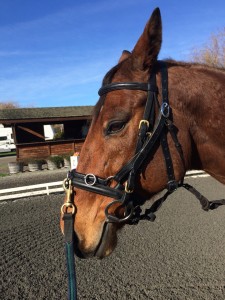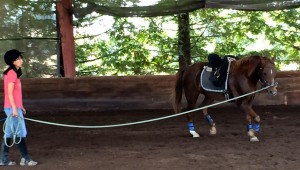Have you asked yourself what is really the point of longeing? Maybe you gave up the idea of longeing your horse because you didn’t know what to do exactly or why. Let’s explore how to get into it. You can find out the benefits of longeing here.
Longeing is so fundamental in horse training that it often gets treated as something too basic to spend much time on. But it is such an important activity with our horses, that we need to spend some time understanding what it is, how to do it, and why we are doing this kind of work. It is a good way to warm them up before riding. It is an essential part of the process of introducing young horses to their training. It helps develop our relationship with them, allowing us to observe our horses and begin an interaction with them that we both can understand and participate. It is also a part of developing our horses’ physical abilities.
Longeing is kind of a strange word. It is pronounced “lunging” so why isn’t it spelled that way? “Longe” means “Long” in French and that is where we get the term. We work with a long line or “longe ligne” in French.
While our horses move around us in a circle on the longe line, there is more going on than meets the eye. The horse and person are developing sophisticated and intricate lines of communication. By placing ourselves alongside the horse and using body language and cues the horse to walk, trot, canter, stop and change direction. We are having a dialogue in a way that makes sense to them that can be developed into all other interactions between the two rather than mechanical commands.
Before we begin longeing, we must make sure that our horses can lead, stop and turn on a lead line. After that we have our horses move in a circle with the longe line by standing next to our horse’s withers facing them and allowing a little slack in the longe line so they have space to move in the circle. Then we take a step toward the haunches to encourage them to move forward and move the whip behind them or lightly tapping them on. We can also use voice commands to help communicate our intentions but we shouldn’t use run on sentences, just clear single word or one or two clucks.
It’s important that your horse develops a habit of matched movement with you. When you step toward him, he needs to move away. When you step back, he follows. This principle is a key to successful longeing and is fundamental to every part of your relationship with him. While we do move with our horses, we don’t chase them around the circle. We want our horses to move around us and we want to move around the center of the circle.
Body language and our position in relation to your horse is the key in your communication with them. Your neutral position is slightly behind his withers that are about the midline of his body. When you step toward him and position yourself slightly behind his midline, it means to move forward in the gait he is in or do a transition to a faster gait (i.e. trot to canter). You need to have a more assertive posture when you step toward him to move them out on the circle and more forward. You will step toward them confidently and expect them to move forward and away. When you position yourself slightly in front of his midline, it means he needs to slow down or do a transition to a slower gait (i.e. trot to walk). When you want them to slow down further or stop, then softly take a step away from them to encourage them to come towards you. Keep yourself both facing them and towards the direction they are traveling.
Our horses need to stay in the size of the circle we ask. A smaller size circle is easier in order to maintain the circle shape. Later you can practice increasing the size of the circle from smaller to larger and maintain direction and rhythm. Your horse needs to stay in a consistent rhythm in whatever gait they are in. Rhythm and direction are two of the most important principles in our horse’s movement and they can be practiced every time we longe our horses.
Refining this dance is at the heart of good longeing practice. You say to the horse to move away from you and move faster or come towards you and move slower maintaining rhythm and direction. Over time, the two of you will hone your communication so that the slightest gesture maintains a smooth circle in a rhythmic gait.
Good practice of longeing means that our horses will move in a circle in all three gaits in rhythm and doing the transitions between the gaits smoothly when we ask. This practice takes time to do well, so be clear but patient with both yourself and your horse as you are learning to longe.
Longeing before riding is a good way to warm up the horse and yourself, but that does not mean that we allow or encourage our horses to run around on the end of the longe line in order to tire them out. That kind of practice is unsafe and reinforces the wrong message. If your horse is overly excited, take the time to have them calmly go on a circle at a good walk before you continue the work.
If your horse is uncooperative by not going forward or staying on the circle, then take time to work on the basics of stopping and going forward when you ask. Be clear with your aids, but if you feel like you need to excessively chase after the horse or use the whip, then there is probably a break down of communication that needs to be addressed. If your horse is too excited and going too fast, then take time to quiet them down and work in the walk before working in the other gaits.
The equipment to use for longeing is a well-fitting cavesson, a cotton web longe line, and a basic longeing whip. Gloves are also advisable for you as well as protective leg boots for your horse. If you don’t have a longeing cavesson, then you can use a basic halter that is neither too tight that it pinches horse’s nose nor too loose that it slips around his head. Longeing can also be done with a bridle, but it is not advisable unless you are well experienced in doing so since damage can be done to a horse’s mouth by excessive pulling on the bit.
Keep your early longeing sessions to less than twenty minutes. We don’t want them to go on a small circle for too long since it can cause stress to their legs especially if it is done at a fast speed.
More questions? That’s great! Please let us know by writing to jburns@sbcglobal.net. Now you are thinking about your horse’s training and how to effectively refine it. As we move forward with the topic of ground work practices, we will talk more about refining your aids, addressing common problems, and then advanced techniques.

